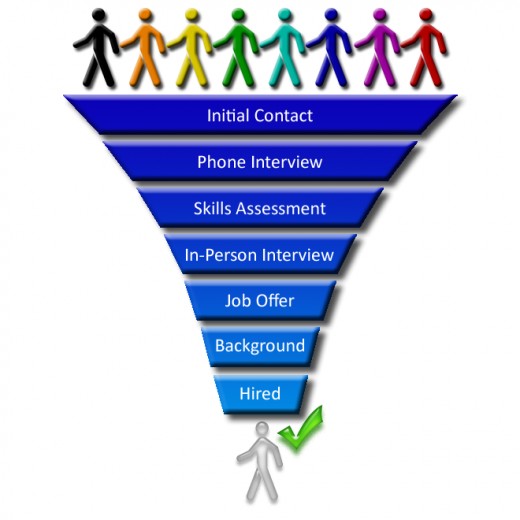The Self Afflicting Job Recruitment Process

The Good Ole Days
Gone are the good ole days of getting a job. The process would go something like this. You would walk into an establishment and start up a friendly conversation with the company owner or foreman as if you’ve been friends for years (because you probably were). The conversation would ensue:
You:
| Hi John. I'm looking for some work.
|
|---|---|
Owner:
| Do you know how to do this sort of work?
|
You:
| Not yet, but I'm a quick learner.
|
Owner:
| When can you start?
|
You:
| Tomorrow.
|
Owner:
| See you 9:00 am sharp. You're hired.
|
The conversation would end with a handshake, and you’d walk away with a new job. This may seem like an over-simplification of the job recruitment process, but I do certainly recall those days when it really was as easy as this.
Modern Recruitment
Nowadays, the process has become so overbearingly complex and exhaustive that getting a job is seemingly an Impossible task that takes more time and effort than the work you would perform once you got the job.
More Than Meets the Eye
This article is by no means a complete assessment or itemization of the full recruitment process. There are hundreds of tasks, laws, procedures and activities that go into the process of recruitment from the employer’s perspective. This article is simply a personal commentary on the recruitment process from the job seeker’s perspective.
Self Affliction
There is a handful of good reasons why the hiring process has become so out of control with excessive processes. However, I ponder the usefulness of such a system when I look at one of the most negative self-afflicting aspects of this new process. The whole process takes so long that by the time you get to the interviewing phase (if you make it that far), you’ve already been out of work for a year and your work history is badly damaged. Now nobody wants you because you have no recent work history. You won’t even get through the initial automated “filtering” phase.
The Current Process
Following is a quick look at the overall recruitment process from the viewpoint of the job candidate. It all begins with searching for available jobs usually on one of the many job boards out there on the Internet. Keep in mind that you may be bumped off the list (or filtered out) and any of the phases shown below.

Initial Contact
Once you find a position that looks like one for which you may be a good fit, you kick off the process by submitting your resume or filling out an application. This gets you into an automated filtering system that will result in a reduced list of candidates based on job requirement vs. experience algorithms. This process may also include filtering on such things as affirmative action and other unspecified filtering controls.
Phone Interview
If you’ve made it through the automated filtering system, you may receive a call from the hiring manager or person in charge of HR to set up a phone interview. This phase is used to give the employer a sense of the candidate's basic background experiences, salary requirements, and availability. It is typically performed by someone on the team of which the successful candidate will be a part.
Skills Assessment Testing
The next phase is not always used, but in technology-based jobs, it is quite common to be asked to take some sort of skills assessment test. This is used to assess the candidate's level of technical or job-related knowledge, skills, and abilities (KSA).
In-Person Interview
This interview (if you’ve made it this far) is mostly to give the employer a better chance to assess your personality and determine whether you are a “good fit” for the position and the organization. It may also be an opportunity for you (the candidate) to decide if the company is a good fit for you.
The Offer
In this phase, the employer has narrowed their list to a couple of final selections. They tentatively offer the position and a salary contingent on their background check (if they haven’t already done one). Salary and benefit negotiations are likely to occur at this phase.
Background Check
Once an offer has been agreed upon, the employer will initiate a background check on you which may include your work history, education, I-9 verification, credit reports, criminal records, and many other factors too numerous to include in this article. Some states may allow this process to be performed as early in the process as the automated filtering phase. This is also the phase in which “legal discrimination” is often employed. There are a plethora of factors by which an employer may legally discriminate against a candidate in order to comply with certain federal and state regulatory controls.
You're Hired
Congratulation! You’ve somehow managed to squeak through all the phases above and come out the “perfect candidate”. You start work on Monday.
The Sad Results
The sad reality is that not only does this process take so long that it shoots itself in the foot, but it quite often results in filtering out extremely great candidates who may not be a “perfect fit”, but could prove to be an amazing asset to the organization.
Furthermore, the company has just spent at least a year’s worth of salary to acquire “the right fit”, and this person will work for 6 months to 2 years, and then just up and leave for greener pastures. This is more common among those under the age of forty, but it happens a lot more than not. It’s no wonder that employers go through such extreme measures to find the right candidate and complain endlessly that filling a position is so difficult. The process of recruitment feeds upon its own self-affliction of dumping potentially good candidates in search of that nugget of gold, only to discover that the value of gold dropped in the mean time.
In Conclusion
I don’t portend to offer any infallible solution, but it sure would seem a lot more feasible and friendly of a system if we could cut out the excess in the middle, and get back to the good ole days of a word of mouth and a handshake. I know, I’m being nostalgic, but hey, one can only dream of a better way.






